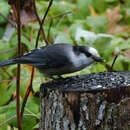en
names in breadcrumbs


Perception Channels: visual ; tactile ; acoustic ; chemical
Perisoreus canadensis is locally common over its wide range, but there is little precise population data. The Breeding Bird Surveys (BBS) from 1966 to 1993 show a -0.6% decline over that period, but with a statistically insignificant sample. The short-term BBS data trend from 1984 to 1993 show a 51.8% increase during that time (P
The Gray Jay is not listed as Endangered or Threatened in the United States or Canada. No special management measures have been implemented for the species.
(Madge 1994, Price 1995)
US Migratory Bird Act: protected
US Federal List: no special status
CITES: no special status
State of Michigan List: no special status
IUCN Red List of Threatened Species: least concern
While many corvids can cause extensive crop damage, the Gray Jay, because of its habitat requirements, does not overlap with farms. It can, however, be an annoyance (some would say a great delight) to campers, as it will linger in campsites and attempt to pilfer food.
Perisoreus canadensis is valuable as an indicator of the health of boreal and sub-alpine systems. Although these areas are less altered than most biomes, acid precipitation and global climate change could have a noticeable effect on this species. Because they are specially adapted to harsh winter environments, Gray Jays may be negatively impacted by warming trends. Thus, the species could serve as an early-warning system for cascading effects of anthropogenic climate change.
Gray Jays are omnivorous, commonly eating arthropods, berries, carrion, eggs, nestling birds, and fungi. Gray Jays use a variety of foraging techniques including flycatching, foliage gleaning, ground gleaning, and even aerial pursuit of rodents. Nestlings are fed partially digested food.
One of the most interesting traits of the Gray Jay is its food storage ability. This Jay has unusually large salivary glands that produce copious sticky saliva. They use this saliva to impregnate and encase food, creating a bolus that will adhere to trees. Away from ground scavengers and protected from the wind and snow, these caches allow efficient food hoarding. Gray Jays have been observed making over 1,000 caches in a single 17-hour day. This behavior may be the major adaptation enabling Perisoreus canadensis to occupy the hostile boreal regions during the winter. Fittingly, the genus Perisoreus means "hoarder."
(Dow 1965, Ehrlich 1988, Strickland 1993, Terres 1995)
Breeding range: The Gray Jay is found from tree line in northern Canada and Alaska south through boreal and subalpine forests to northern California on the west coast, Arizona and New Mexico in the Rocky Mountains, northern Wisconsin in the midwest, and New York in the east.
Winter range: The non-breeding range is essentially the same as the breeding range, as the Gray Jay does not migrate except for (in late fall and winter) occasional altitudinal movements in the Rockies and rare latitudinal movements elsewhere, probably due to food shortages.
Perisoreus canadensis has never been recorded outside of North America.
(Sibley 2000, Strickland 1993, Ehrlich 1988)
Biogeographic Regions: nearctic (Native )
Gray Jays are associated with coniferous and coniferous-deciduous forests of the boreal and sub-alpine vegetative regions. They are most commonly found in spruce and fir woods (with occasional aspens or birch). Despite its association with humans, this jay does not live in towns or developments. It is exclusively a bird of remote forests. In fact, Gray Jays disappear as soon as a camp becomes a permanent settlement.
(Strickland 1993, Madge 1994, Goodwin 1986)
Average lifespan
Status: wild: 185 months.
Often described as resembling an oversized chickadee, P. canadensis is a fluffy, pale-gray, long-tailed, short-billed, crestless jay. Gray Jays, while sexually monomorphic, do show strong regional variation, with three distinguishable populations: Pacific, Rocky Mountain, and Taiga. All adult variations have black eyes, bills, legs, and feet and white auriculars (ear patches) and throats. Pacific birds show extensive dark on the head and brownish-tinged backs. Rocky Mountain birds south of Canada have a whiter head. Taiga birds resemble Pacific birds, but are grayer above and have a grayer (rather than whitish) belly. Juveniles from all populations are sooty overall and gray-billed with white malar stripes.
Perisoreus canadensis is 11.5 inches (29 cm) long and has a wingspan of 18 inches (45 cm). Normal adult weight is 2.5 ounces (70 grams).
Gray Jays have a clear, pleasant whistle of wheeeooo or wheee-ah. Calls also include a low, husky chuf-chuf-weef and a very rough, dry kreh kreh kreh kreh alarm call. Like Blue Jays, P. canadensis sometimes sound a screeching jaaay. Gray Jays are known to mimic sounds.
(Sibley 2000, Peterson 1990)
Other Physical Features: endothermic ; bilateral symmetry
Average mass: 70.3 g.
Perisoreus canadensis breeds in coniferous forests and sometimes in mixed coniferous-deciduous woodlands. The male chooses a nest site usually in a conifer (spruce or fir), at a height of 5 to 12 feet (1.5 - 3.6 m), sometimes as high as 30 feet (9.1 m). The male initiates building the nest - a thick cup of twigs, bark strips, grass, moss, lichen, and spider webs. The inside is lined with fine grasses, moss, hair, feathers, and fur. The female joins the building over a period of up to 3 weeks or more.
The breeding season begins in March, while snow is still on the ground and temperatures are well below freezing, and ends by mid-May. Curiously, second broods are not attempted in ostensibly favorable later months. Three to four eggs (29 X 21 mm) are laid (range 2-5) and incubated by the female alone. The eggs are pale greenish or gray-green and heavily speckled, spotted, or blotched with olive and paler gray. After a 16 to 18 day incubation period, the nestlings hatch slightly downy and altricial. The young are fed by both parents and fledge at 22 to 24 days.
Cowbird parasitism has not been observed.
(Baicich 1997, Veghte 1964)
Key Reproductive Features: iteroparous ; gonochoric/gonochoristic/dioecious (sexes separate); sexual ; oviparous
Average time to hatching: 17 days.
Average eggs per season: 3.